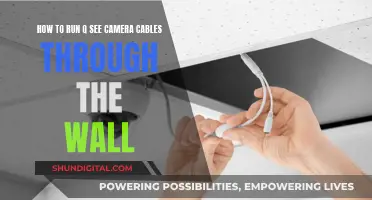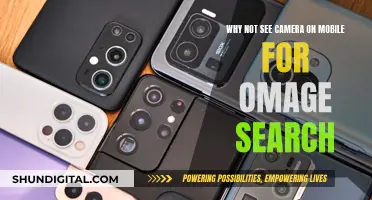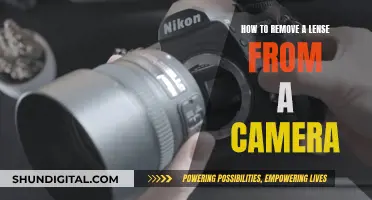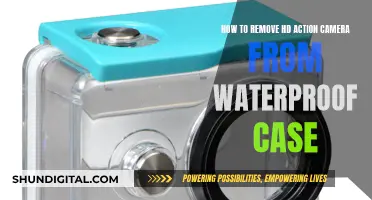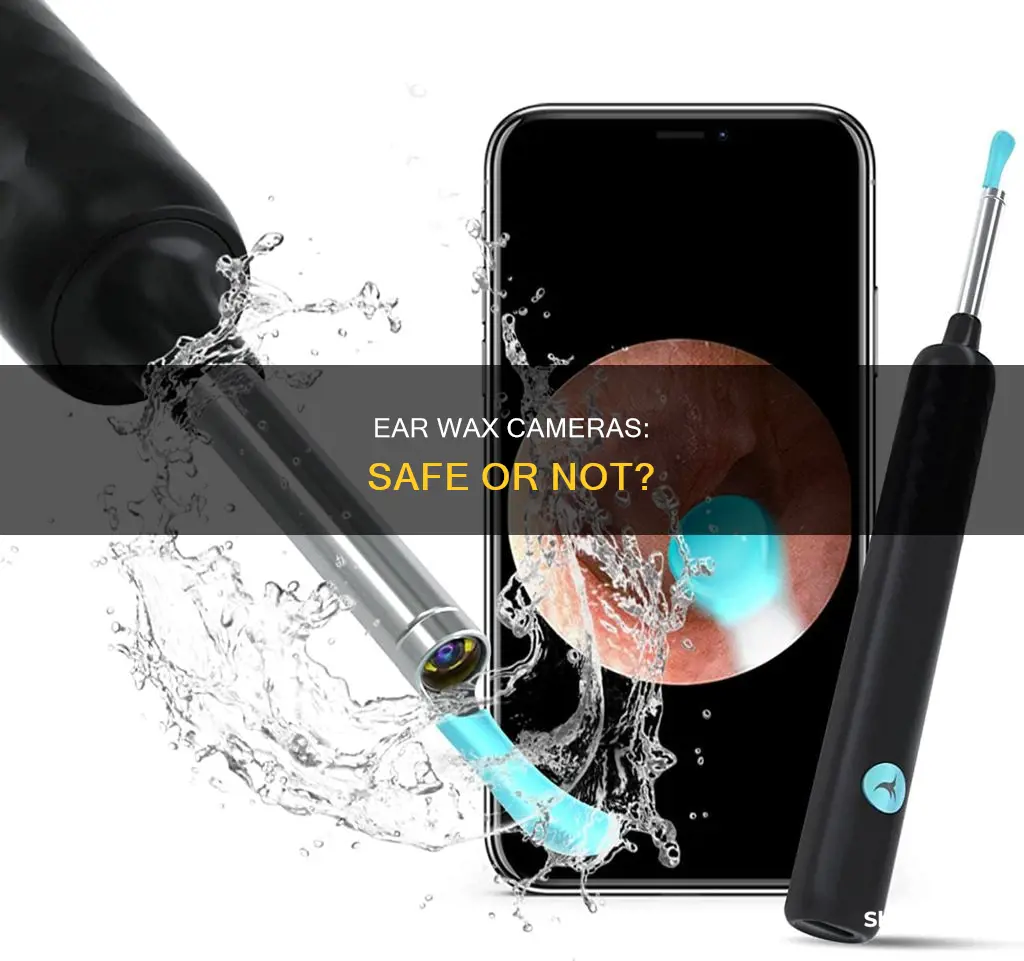
Ear wax removal cameras are a popular topic on social media, with many viral videos showing people cleaning their ears. These devices are small, pen-like tools with LED torches and a camera that connects to a smartphone, allowing users to see inside their ear canal. While these devices offer a cheap and fascinating way to visualise the inside of your ear, there are safety concerns. Healthcare professionals warn that using these devices without proper training can cause significant and lasting trauma to the ear. The ear canal has very sensitive skin that is easily damaged, and improper use of ear wax removal cameras can lead to infection, wax impaction, or damage to the ear canal or eardrum. As such, it is recommended that individuals refrain from using at-home ear wax removal kits and instead seek treatment from a specialist.
| Characteristics | Values |
|---|---|
| Price | Budget-friendly, as low as £9.99 |
| Design | Small, pen-like tools with interchangeable tips |
| Features | LED torches, live image/video streaming to smartphones, wireless connectivity |
| Safety | Potential for pain and damage to the ear canal or eardrum, risk of infection, wax impaction, and hearing loss |
| Effectiveness | Difficult to use, poor picture quality, depth perception issues, ineffective in wax removal |
| Regulation | Minimally regulated, clinically unevaluated |
What You'll Learn
- Ear wax removal cameras are often pen-like tools with LED torches, streaming live images to a smart device
- They are available for as little as £9.99 on sites like Temu, Amazon and eBay
- The biggest risk is causing trauma to the ear canal or eardrum, which is very sensitive and easy to damage
- They are difficult to use, with poor picture quality and movement lag
- Professionals advise against using them, recommending alternative methods such as irrigation or ear drops

Ear wax removal cameras are often pen-like tools with LED torches, streaming live images to a smart device
The devices are marketed as safe, cost-effective, user-friendly solutions to ear wax removal. However, healthcare professionals advise against their use, citing the risk of causing significant and lasting trauma to the ear canal and eardrum. The ear canal has very sensitive skin lining, and the eardrum is only 0.1mm thick. Without professional training, it is easy to damage the ear canal and eardrum, which could lead to infection, wax impaction, and hearing loss.
The cameras are often accompanied by interchangeable tips or wire loops that are used to dislodge and remove earwax from the ear. However, manipulating these tips or loops inside the ear can be challenging, even for healthcare professionals. The camera's picture quality and movement lag can make it difficult to gauge depth perception, increasing the risk of injury.
Furthermore, just because one can see inside the ear canal, it doesn't mean they know how to interpret what they are seeing. Ear-related problems, including ear wax buildup, should be diagnosed by a professional who can advise the correct treatment. Even when used as intended, at-home ear wax removal cameras are not considered effective in removing ear wax.
While ear wax removal cameras may seem like a convenient and cost-effective solution, it is essential to weigh the risks involved. Doing nothing or using a wax softener like Debrox or olive oil drops is often a safer and more effective approach to ear wax removal than using at-home tools.
Ghostly Visions: Special Cameras for Ghost Sightings
You may want to see also

They are available for as little as £9.99 on sites like Temu, Amazon and eBay
Ear wax removal cameras are widely available online for as little as £9.99 on sites like Temu, Amazon and eBay. These devices are usually pen-like tools with LED torches and the ability to stream live images or video from the ear to a smart device. They often come with a selection of interchangeable tips to help remove earwax.
Manufacturers of these devices claim they provide a safe, cost-effective and easy way to remove ear wax at home. However, healthcare professionals advise against using these tools. They argue that the ear canal has very sensitive skin that is easy to damage, and that the average person will not be able to adequately sterilise these tools at home.
ENT surgeon Vic Veer comments that ear wax removal cameras are difficult to use, even on others. He suggests that their use would likely cause pain and potential damage to the ear canal. Dr Peerless, an ear, nose and throat specialist, agrees, stating that "just because you can look in your ear doesn't mean you should".
Clear Wax Solutions, an ear wax removal service, warns that untrained use of these devices can lead to "significant and lasting trauma". They recommend seeking a trained professional for ear wax removal, such as their service which uses the gentle and effective method of irrigation.
Enabling Ome TV Camera: A Simple Guide
You may want to see also

The biggest risk is causing trauma to the ear canal or eardrum, which is very sensitive and easy to damage
Ear wax removal cameras are often marketed as safe and cost-effective solutions for ear wax removal. However, the biggest risk of using these devices is causing trauma to the ear canal or eardrum, which are very sensitive and easy to damage.
The ear canal has a thin skin lining that is only about 2.5 centimetres long, and the eardrum itself is only 0.1mm thick. This makes it extremely easy to damage, even with a slight mistake or mishandling of the device. The skin of the ear canal is very delicate, and using an ear wax removal camera can lead to scratching, abrasion, or puncturing of the eardrum. Such damage can cause severe pain and potentially lead to hearing loss or ringing in the ears.
The risk of causing trauma is significantly increased when these devices are operated by people without proper training. Healthcare professionals warn that just because you can see inside your ear, it doesn't mean you know what you're looking at. Every ear is unique, and without professional knowledge, it's challenging to distinguish between normal and abnormal conditions. For example, a feeling of fullness in the ear could be due to ear wax buildup, but it could also be a sign of other conditions such as a respiratory infection or fluid behind the eardrum.
Additionally, the design and materials of these consumer-grade devices are inferior to professional-grade equipment. The overall quality of their design, materials, and functions cannot match those of professional tools. The average person will also not be able to adequately sterilise these tools at home, increasing the risk of infection.
In conclusion, the biggest risk of using ear wax removal cameras is causing trauma to the ear canal or eardrum due to their sensitive nature and the potential for mishandling by untrained individuals. It is strongly recommended to seek treatment from a specialist instead of attempting ear wax removal at home with these devices.
Mysterious Orbs: What Causes Them in Camera Photos?
You may want to see also

They are difficult to use, with poor picture quality and movement lag
Ear wax removal cameras are often marketed as being easy to use, with some devices being operable with one hand. However, the reality is that they are difficult to use, especially on oneself. ENT surgeon Vic Veer comments that these devices are challenging to use, even when trying to clean someone else's ears. The picture quality and movement lag are poor, and it is hard to gauge depth perception. This can lead to users going too far into the ear canal, causing damage to the sensitive skin lining or the eardrum. The eardrum is only 0.1mm thick, and it is easy to cause a puncture, which can result in immediate sharp pain, ringing in the ear, or hearing loss.
The camera's poor image quality and movement lag make it difficult to manoeuvre the device accurately. The user must try to keep their hand steady while also dealing with the lag and poor-quality images. This challenge is further compounded by the difficulty in determining left and right movements. The ear wax removal cameras often have interchangeable tips that can be used to dislodge and remove earwax. However, the metal loops or wires attached to these tips can move around too much, making the process even more challenging.
The camera's limited field of view can also obstruct the user's ability to see the earwax clearly. In some cases, the camera may be too big, leaving insufficient room in the ear canal to insert the camera and effectively remove the earwax. This obstruction can result in users pushing the camera too far into the ear or using excessive force, leading to potential damage to the delicate structures within the ear.
The combination of poor picture quality, movement lag, and limited field of view can make it challenging for users to accurately perceive the depth and dimensions of the ear canal. This can lead to incorrect estimations of how far to insert the device, increasing the risk of causing trauma to the ear.
Accessing Street Camera Footage: A Step-by-Step Guide
You may want to see also

Professionals advise against using them, recommending alternative methods such as irrigation or ear drops
Ear wax removal cameras are widely available and often marketed as a safe, cost-effective solution to ear wax removal. However, healthcare professionals advise against using these devices due to safety concerns and recommend alternative methods such as irrigation or ear drops.
The ear canal has very sensitive skin lining, which is extremely delicate and susceptible to damage. Without proper training, it is easy to cause significant and lasting trauma to the ear canal or eardrum, which can lead to severe consequences, including infection, wax impaction, and hearing loss. The risk of causing harm is further increased by the fact that these devices are often operated by people without the necessary training or understanding of ear anatomy.
Professionals, such as audiologists and ear, nose, and throat specialists, recommend alternative methods for ear wax removal. Irrigation, also known as ear stringing, is a gentle and effective method recommended by the National Institute for Clinical Excellence (NICE). This procedure involves gently pulsating warm water into the ear canal to dislodge and remove the wax. Another recommended method is the use of ear drops or spray, such as olive oil, administered twice a day for 5 to 7 days before an appointment. These methods are considered safer and more effective than ear wax removal cameras and should only be performed by trained professionals to avoid any potential complications.
It is important to note that ear wax has a self-cleaning function, and in most cases, the body can remove excess wax on its own. While it is understandable to be concerned about ear wax buildup, seeking professional advice and treatment is always the safest option.
Techniques to See Through Walls and Cameras Revealed
You may want to see also




